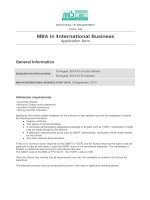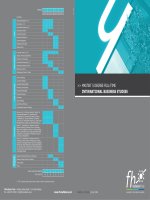International business 7e czinkota moffett ch17
Bạn đang xem bản rút gọn của tài liệu. Xem và tải ngay bản đầy đủ của tài liệu tại đây (661.09 KB, 24 trang )
Chapter 17
Financial Management
1
Learning Objectives
To understand how value is measured
and managed across the multiple units
of the multinational firm.
To understand how international business
and investment activity alters and adds to
the traditional financial management
activities of the firm.
To understand the three primary currency
exposures that confront the multinational
firm.
To examine how exchange rate changes alter
the value of the firm, and how management
can manage or hedge these exposures.
2
The Goal of Management
The goal for most Anglo-American
markets is stockholder maximization - the
management of the company seeks to
maximize the returns to stockholders by
working to push share prices up and to
continually grow dividends.
The goal for most Continental European
and Japanese firms is corporate wealth
maximization - considering the financial
and social health of all stakeholders.
3
Global Financial Goals
The three primary financial objectives are:
1. Maximization of
consolidated, after-tax
income.
2. Minimization of the firm’s
effective global
tax burden.
3. Correct positioning of the
firm’s income, cash flows,
and available funds.
4
Genus Corporation and
Foreign Subsidiaries
Genus Corporation
(USA)
Brazil
Moderate Tax
Unstable Currency
Limited Funds Movement
Germany
High Tax
Stable Currency
Free Funds Movement
China
Low Tax
Stable Currency
Blocked Funds
5
Multinational Management at
Genus
The primary goal of the firm is the maximization
of consolidated profits, after tax.
Consolidated profits are the profits of all the
individual units of the firm originating in many
different currencies.
Each of the incorporated units of the firm has its
own set of traditional financial statements,
which are expressed in the local currency.
The shareholders of Genus track the firm’s
financial performance on the basis of earnings
per share (EPS).
Each affiliate is located within a country’s
borders and is therefore subject to all laws and
regulations within that country.
6
Evaluating Potential Foreign
Investment
Evaluating the potential for foreign
investment includes:
Capital budgeting - the process of evaluating the
financial feasibility of an individual investment.
Capital structure - the determination of the relative
quantities of debt capital and equity capital that will
constitute the funding of the investment.
Working capital and cash flow management - the
management of operating the financial cash flows
passing in and out of a specific investment project.
7
Financial Trust
Unlike most domestic business,
international business often occurs
between two parties that do not know each
other very well.
In order to conduct business, a large
degree of financial trust must exist.
Financial trust is the trust that the buyer
of a product will actually pay for it
on or after delivery.
8
Financial Trust Using a Letter
of Credit (L/C)
3
Yokohama Bank
(Japan)
1
2
Endaka Construction
(Japan)
Pacific First Bank
(United States)
Financing of trade
with L/C
Old-growth
pine lumber
exported
6
&
4
7
Vanport Lumber
Company
(United States)
5
9
Financial Trust Using a Letter
of Credit (L/C)
1. Endaka Construction requests a letter of credit to
be issued by its bank.
2. Yokohama Bank will determine if Endaka is
financially sound and capable of making the
payments required.
3. Yokohama Bank issues the letter of credit to the
exporter’s bank, Pacific First Bank.
4. Pacific First assures Vanport that payment will be
made after evaluating the letter of credit.
5. The lumber order is loaded onboard the shipper.
6. Vanport draws a draft against Yokohama Bank for
payment.
7. Pacific Bank confirms the letter of credit and
collects from Yokohama Bank.
10
Multinational Investing
An investment is financially justified if it
has a positive net present value (NPV).
The construction of a capital budget is
the process of projecting the net
operating cash flows of the potential
investment to determine if it is indeed a
good investment.
A capital budget is composed primarily of
cash flow components.
11
Capital Budget Components
Initial Expenses and
Capital Outlays
Operating Cash Flows
Terminal Cash Flows
12
Risks in International
Investments
Risks are higher for international
investments than domestic investments.
The risk arises from the different
countries, their laws, regulations,
potential for interference with the normal
operations of the investment project, and
currencies.
Foreign governments have the ability to
pass new laws, increasing risk for a parent
company.
Another risk issue is that the viewpoint or
perspective of the parent and the project
may no longer be the same.
13
International Cash Flow
Management
Cash management is the financing of shortterm or current assets.
Operating cash flows arise from the
everyday business activities of the firm
such as paying for materials or resources or
receiving payments for items sold.
Financing cash flows arise from the funding
activities of the firm. The servicing of
existing funding resources, interest on
existing debt, and dividend payments to
shareholders constitute frequent cash
flows.
14
Transfer Prices
The prices at which multinational
firms sell their products to their
subsidiaries and affiliates are
called transfer prices.
Theoretically, they are equivalent
to what the product would cost if
purchased on the open market.
Sometimes, transfer prices are
set internally, which may result in
the subsidiary being more or less
profitable.
15
Cash Management
Netting, which combines cash flows between
subsidiaries and parent companies, is particularly
helpful if the two way flow is in two currencies.
Combining capital, or cash pooling, allows a firm
to spend less in terms of foregone interest on
cash balances.
A foreign subsidiary that is expecting its local
currency to fall in value relative to that of the
parent company may try to speed up, or lead its
payments to the parent.
If the local currency is expected to rise versus
that of the parent company, the subsidiary may
want to wait, or lag payments.
16
Cash Management (cont.)
Reinvoicing occurs when one
office in a multinational firm
takes ownership of all
invoices and payments
between units.
An internal bank can be
established within a firm if its
financial resources and needs
are either too large or too
sophisticated for the financial
services that are available in
local subsidiary markets.
17
Types of Foreign Currency
Exposure
Transaction Exposure
Economic Exposure
Translation Exposure
18
Transaction Exposure
Transaction exposure is the risk
associated with a contractual payment
of foreign currency.
It is the most common type of exchange
risk.
The two conditions necessary for a
transaction exposure to exist are:
1. A cash flow that is denominated in a
foreign country.
2. The cash flow will occur at a future date.
19
Transaction Exposure (cont.)
Managing transaction exposures usually is
accomplished by either natural hedging or
contractual hedging.
Natural hedging describes how a firm might
arrange to have foreign currency cash flows
coming in and going out at roughly the same times
and same amounts.
Contractual hedging is when a firm uses financial
contracts to hedge the transaction exposure. The
most common foreign currency contractual hedge
is the forward contract.
Firms that import or export on a continuing
basis have constant transaction exposures.
20
Economic Exposure
Economic exposure is the risk to the firm
that its long-term cash flows will be
affected, positively or negatively, by
unexpected future exchange rate
changes.
It emphasizes that there is a limit to a
firm’s ability to predict either cash flows
or exchange rate changes in the medium
to long term.
Management of economic exposure is
being prepared for the unexpected.
21
Translation Exposure
Translation exposure is the
risk that arises from the
legal requirement that all
firms consolidate their
financial statements of all
worldwide operations
annually.
Unlike transaction and
economic exposures, which
are “true” exposures,
translation exposure is an
economic problem.
22
Countertrade
Countertrade is a sale that encompasses
more than an exchange of goods, services,
or ideas for money.
Historically, countertrade was mainly
conducted in the form of barter, which is a
direct exchange of goods of approximately
equal value, with no money involved.
Conditions that encourage countertrade
are:
lack of money,
lack of value of or faith in money,
lack of acceptability of money as an exchange
medium,
greater ease of transaction by using goods.
23
Reasons for Countertrade
Increasingly, countries and companies are
deciding that sometimes countertrade
transactions are more beneficial than
transactions based on financial exchange.
The use of countertrade permits the
covert reduction of prices and therefore
allows the circumvention of price and
exchange controls.
Many countries are responding favorably
to the notion of bilateralism.
Countertrade is viewed as an excellent
mechanism to gain entry into new
markets.
24









